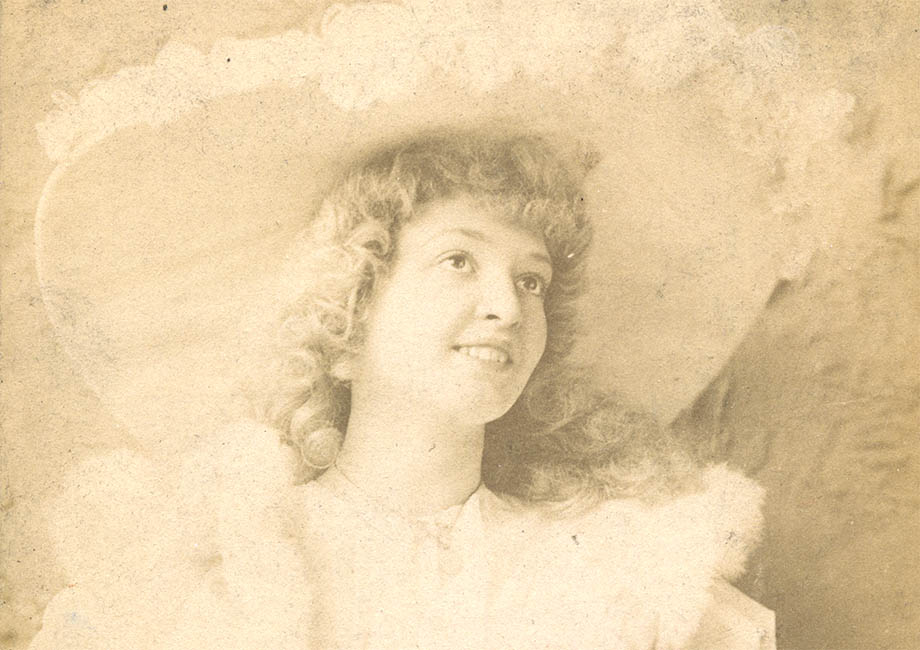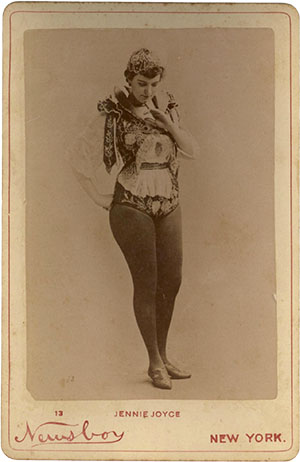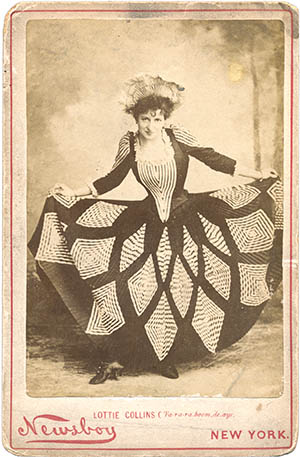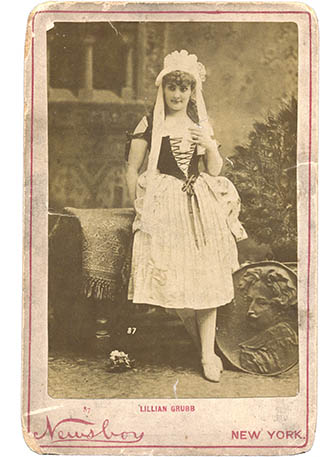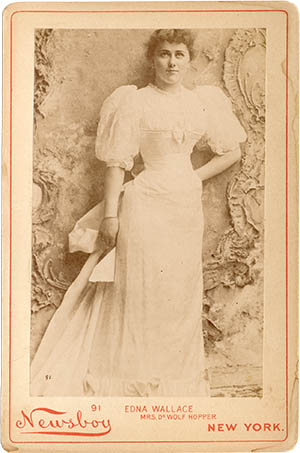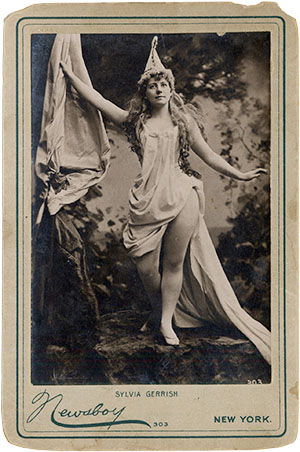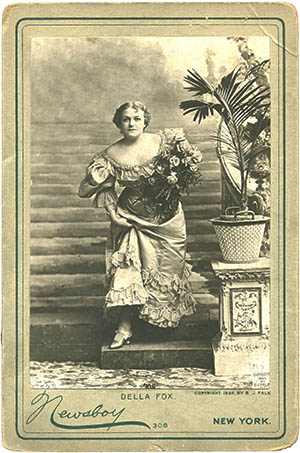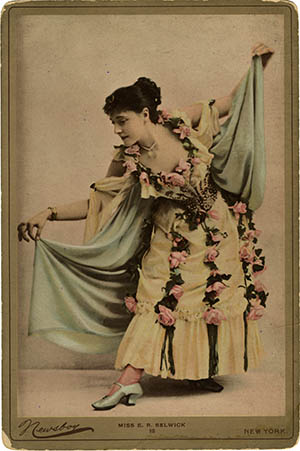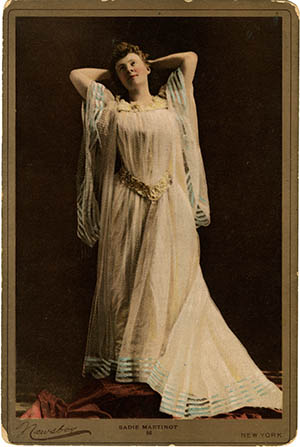This detail of the absolutely angelic-looking actress Alice Evans (although you just know she wasn’t an angel) dates to about 1892.1 It was from the first series (no. 16, printed on the card and written on the photo) of cabinet cards issued as a premium with Newsboy plug tobacco and an early example of what would become known as the tobacco card.2 Here is an alternate version (still no. 16) of our not-really-an-angel:

The Newsboy cards were not lithographed package stiffeners like the typical tobacco card, but were full-size cabinet cards available as premiums from tobacconists or druggists, or by mail in exchange for package tags. The cabinets included mostly Broadway stage actresses, but also actors and sports figures (including some baseball players3 and boxers), and later, famous people (including Edison and McKinley), important landmarks and warships. But forget the warships, for now let’s concentrate our energies on the hot Victorian babes.
The first two series of cards, albumen prints mounted on cards with red printing (in many different variations), consisted of 136 numbered cards (1―136) and 227 cards (1―227):
No. 13 Jennie Joyce. University of Florida
No. 41 Lottie Collins4 and no. 87 Lillian Grubb
No. 91 Edna Wallace. Ohio State University
The third series consisted of silver gelatin prints mounted on gray cards with green printing (Nos. 301—385):
No. 303 Sylvia Garrish. Ohio State University
No. 308 Della Fox
The fourth and fifth series were mounted on white cards with red or brown printing (Nos. 502—604 and 800—841).
The last series was advertised as a "Handsomely colored photographs given free with each 10 cent plug of Newsboy tobacco...100 different photographs of beautiful women in this collection." They were, of course, not photographs, but boudoir-sized chromolithographs:
No. 52 Hattie Harvey. University of Florida
No. 83 Ethel Rose Selwick and no. 89 Clara Lippmann
No. 96 Sadie Martinot
After this last series of cabinets, Newsboy continued to offer cards as premiums, but they were much smaller package-sized lithographs.
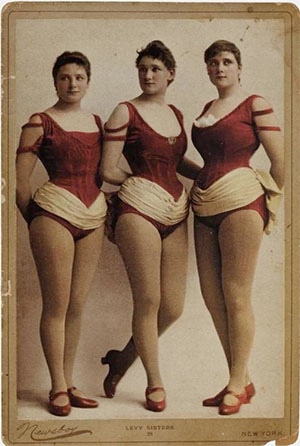
No. 28 The Levy Sisters
1. Alice Evans, a relatively minor actress with the Hoyt Company married the noted old-school actor Wilton Lackaye (of Svengali fame) on 2 Sep 1895 in what was described as a rushed ceremony. After the birth of her son Wilton Jr in 1902 she largely retired from the stage.
She was a close friend of Evelyn Nesbit, who gained notoriety when her former lover, the architect Stanford White, was murdered in a fit of rage by her sadistic, cocaine-addled, millionaire husband Harry Thaw. At Thaw’s sensational 1907 trial, Alice was Evelyn’s constant companion. As Irvin Cobb wrote for McClure’s: “There was Evelyn Nesbit Thaw...always with her her little actress friend at her side.” Alice apparently created quite a stir due to her scandalous attire during Evelyn’s testimony, after which she was asked not to return to court. As the San Francisco Call reported on 4 Aug “The disappearance of Mrs. Alice E. Evans has been noted.”
She died on 5 Aug 1919 after an illness of several months. Here is one more cabinet card from the New York studio of Benjamin Falk:
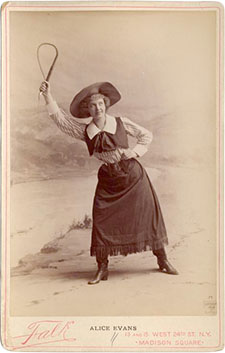
2. Newsboy was a brand of the National Tobacco Works, 1806 W. Main Street, Louisville, KY, or, after it was sold to the American Tobacco Company in 1892 (for 2.2 million USD), P.O. Box 2591, 45 Broadway, New York City.
3. The original Newsboy series included 14 images of baseball players, mostly from the 1894 New York Giants championship team, including the hall-of-fame pitcher Amos Rusie (No. 175) Along with the Old Judge series of cabinets (Goodwin & Co.), they are some of the earliest known baseball cards. Although not as valuable as, say, a T206 Wagner, they still are quite desirable, especially in good condition. Needless to say I don’t have any of these.
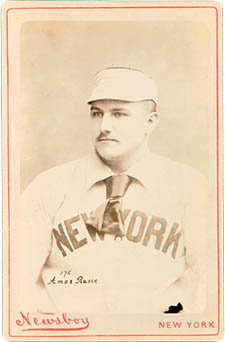
4. Charlotte Louisa Collins, AKA Lottie Collins (1865—3 May 1910) was an English singer and dancer. She is best known for her provocative can-can version of the 1891 Henry J. Sayers Vaudeville song “Ta-ra-ra Boom-de-ay.” The melody, which, trust me, you know, was the basis of the Howdy Doody theme. A more contemporary version was sung by the Dilly Sisters (AKA Las Hermanas Nuñez) on Hanna-Barbera’s ultra-bizarre, pop-art, don’t-watch-this-on-acid children’s show, the Banana Splits Adventure Hour (1968―1970).
30 May 2009, updated 30 Dec 2014 ‧ Photography
